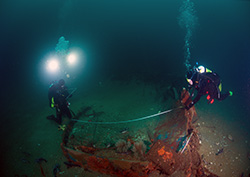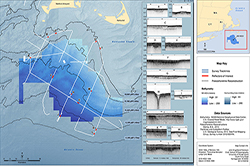The mission of the Bureau of Ocean Energy Management’s Office of Renewable Energy Programs (OREP) is to regulate environmentally-responsible offshore renewable energy development activities. In support of that objective, the archaeologists in OREP coordinate studies and conduct Section 106 reviews under the National Historic Preservation Act, which are intended to identify and protect archaeological sites and other historic properties.
Historic properties on the Outer Continental Shelf (OCS) include historic shipwrecks, sunken aircraft, lighthouses, and pre-contact archaeological sites that have become inundated due to global sea level rise since the height of the last ice age ca. 19,000 years ago. Pre-contact archaeological sites are those that date to the time before European contact with Native Americans. Historic properties onshore (e.g., sites, buildings, and districts) are also considered where they may be affected by a proposed renewable energy project.
Reviews under Section 106 of the National Historic Preservation Act
Section 106 of the National Historic Preservation Act (NHPA) requires federal agencies to take into account the effects of their undertakings on historic properties and afford the Advisory Council on Historic Preservation an opportunity to comment. OREP archaeologists help BOEM meets its obligations under the NHPA by conducting detailed reviews according to 36 CFR Part 800 and coordinating those reviews with OREP’s analyses under the National Environmental Policy Act. The following constitute documentation relating to Section 106 review activities for ongoing renewable energy projects on the Atlantic OCS.
- North Atlantic Wind Energy Areas
- Mid-Atlantic Wind Energy Areas
- South Atlantic Renewable Energy Activities
Guidelines for Identification of Historic Properties in Federal Waters
BOEM's regulations at 30 CFR Part 585 require renewable energy developers to provide the results of detailed site characterization surveys in order for the bureau to conduct the required technical and environmental review of an applicant's plan. Our current guidelines for collecting and submitting these data, Guidelines for Providing Archaeological and Historic Property Information Pursuant to 30 CFR Part 585, include recommendations on the appropriate methods to identify historic properties located on the OCS. These guidelines are subject to revision as new technology develops, studies are completed, and consultations inform our scope of identification efforts. For onshore areas or areas in state waters, OREP recommends contacting the relevant State Historic Preservation Officer for guidance on the appropriate methods and level of effort to identify historic properties in these areas.

Studies
OREP archaeologists also support a number of studies, many of which involve interdisciplinary approaches and substantial interagency collaboration. OREP archaeologists work alongside the marine scientists and technologists of the United States Geological Survey Woods Hole Coastal and Marine Science Center, the National Oceanic and Atmospheric Administration's National Marine Sanctuaries, the National Park Service Submerged Resources Center, and many others.
The following constitute BOEM's completed or ongoing renewable energy studies relating to archaeology or historic preservation on the Atlantic OCS.

For more information
Explore the following links for more information on BOEM’s studies, archaeology and historic preservation, and renewable energy activities in other regions.
- Gulf of Mexico Region archaeology
- Pacific Region renewable energy activities
- BOEM’s Environmental Studies Program
Contact
[email protected]
OREP/Atlantic Regional Historic Preservation Officer
Bureau of Ocean Energy Management
Office of Renewable Energy
45600 Woodland Road,
Sterling, Virginia 20166
703-787-1549




